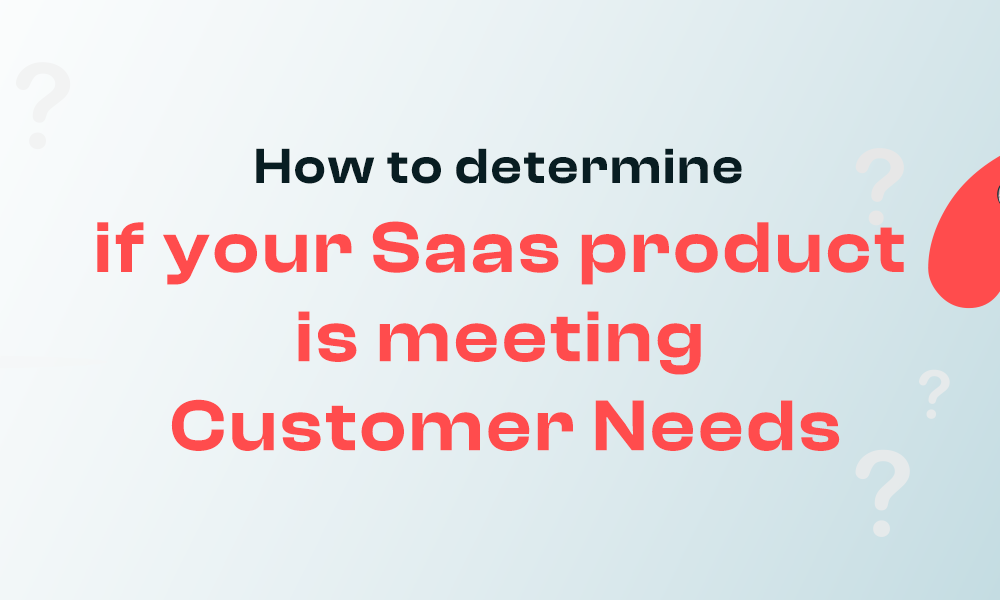



Are you offering a SaaS product, but not sure if it’s meeting customer needs? It can be frustrating not knowing whether all the hard work and resources invested in developing your software-as-a-service is paying off.
But don’t worry–there are simple ways to measure success! In this article we’ll explore how to determine if your SaaS product is truly satisfying customers’ expectations.
With some effort and dedication, you can ensure that your product meets their needs, and make necessary changes where needed. Let’s get started on figuring out if you’re hitting the mark with your clients!
Who would have thought that the key to understanding customer needs was right in front of us all along! Listening to calls, engaging forums, analyzing usage data – it turns out there are multiple ways for SaaS providers to determine if their product meets customer needs.
One way is by collecting feedback from customers through a combination of surveys and other methods. This can include one-on-one conversations with users or phone interviews with those who recently made use of your services. By doing this, you’ll be able to gain insight into how they perceive your product and whether any changes need to be made.
Additionally, setting up an online forum where customers can freely discuss their experience can also provide valuable information about what’s working well and what isn’t.
It’s important not to overlook user reviews either; these often contain honest opinions on our products and services which are invaluable when attempting to improve them. Being proactive in responding quickly to positive and negative feedback will show customers that we’re listening and taking their opinion seriously – something that’ll go a long way towards building trust between both parties.
With this knowledge at hand, let’s look at another approach: analyzing usage data.
Analyzing usage data is a key element in determining if your SaaS product is meeting customer needs. This process involves looking at tracking trends and utilizing analytics to gain insight into how users are interacting with the product.
By paying close attention to user behavior, you can identify areas for improvement or changes that need to be made in order to ensure customers are getting the most value from their purchase.
It’s also important to look beyond just objective metrics when analyzing usage data. Gathering qualitative feedback from customers through surveys, interviews, and focus groups will give you even more valuable information about what they want and expect out of the product.
In addition, examining support requests can help uncover any pain points or issues customers may have experienced while using your software.
By combining both quantitative and qualitative analysis together, you’ll have a much clearer picture of where your SaaS product stands in terms of customer satisfaction. With this knowledge, you can make informed decisions on how best to adjust features, pricing models, and other elements within the product experience so it better meets customer expectations.
From there, it’s simply a matter of continually monitoring user activity over time as well as updating your strategies accordingly. As such transitions occur seamlessly between sections without breaking readers’ flow of thought making it easier for them to understand complex concepts quickly and accurately.
Analyzing usage data can provide an abundance of valuable insights into customer needs. A recent study revealed that nearly 70% of customers who used a company’s product for two weeks continued to use it in the long term. This statistic indicates that customers are engaging with the product and finding value from it, but there is still more to uncover when trying to determine if a SAAS product meets customer needs.
Next step in the process of evaluating customer satisfaction involves examining support requests. Investigating trends among users and engaging them through surveys or interviews can help identify any issues they have experienced while using a particular service.
By understanding individual user experiences, companies can improve their products and services so that each person’s needs are met efficiently and effectively. Additionally, looking at churn rates—or how quickly people stop using your product—can also be beneficial in determining overall customer satisfaction levels.
Let’s start by looking at how to analyze churn rates, and then discuss the impact churn rates can have on a SaaS product.
Adjust the paragraph structure in the Input to logically group complete sentences on their own lines, with a double new line after.
If you’re looking to determine if your SaaS product is meeting customer needs, analyzing the churn rate of your customers should be at the top of your list.
Identifying trends and tracking changes over time are key indicators in understanding what’s working and what needs improvement.
Churn rates can help you better understand how satisfied customers are with their experience and whether they’ll remain loyal in the long-term or eventually discontinue use of your product.
Keeping an eye on this metric will give you a clearer picture as to whether or not your product is resonating with users – so make sure to keep it high on the priority list!
The impact of churn rates can be wide-reaching and should not be taken lightly.
For starters, it’s important to identify trends in customer profiles so you can get a better idea of who is more likely to stick around for the long haul.
This way, you’ll know which segments are worth investing time and resources into versus those that may need further attention or improvement.
Additionally, tracking changes over time will also help you understand how customers’ satisfaction levels shift as your product continues to evolve – this could open up new opportunities for revenue growth if done correctly.
In sum, understanding churn rates and its implications on your business can make all the difference when it comes to success – so don’t forget about it!
When it comes to evaluating customer needs, surveys are a great way of determining if your SaaS product is meeting customers’ expectations. Proper survey design and customer segmentation can ensure that you get the most accurate information possible from your target audience.
To make sure that you properly evaluate customer satisfaction, there are several things to consider when designing your survey:
Analyzing customer feedback through surveys helps uncover areas where improvements may need to be made so that customers have an optimal experience with your software. Keeping this in mind when crafting and implementing surveys gives you a chance to truly understand what customers think of your product – allowing you to make necessary changes quickly and effectively.
Engaging with customers is an essential part of ensuring your product meets their needs. The best way to do this is by actively crowdsourcing feedback and conducting A/B testing. To get started, imagine a world in which you can quickly understand the wants and needs of those who use your services; it’s like stepping into a dreamscape where customer satisfaction reigns supreme. Crowdsourcing allows you to collect data from people who are already invested in your brand, while A/B testing gives you insight into what features users find most appealing or useful. By utilizing both methods together, you’ll be able to gain valuable insights that will help ensure your SaaS product is meeting customer needs.
Analyzing usage data is a great way to understand how customers are using your product and ensure it’s meeting their needs. By gathering insights from trends in the data, you can make decisions on features or changes that will improve the user experience and better meet customer expectations. This type of analysis also helps you identify areas that may need further research and testing before making any significant changes.
As the old saying goes, time is money and customers expect prompt support when they need it. Staying on top of customer support requests can be a daunting task but with proper audit processes and escalation strategies in place, you can ensure that your SaaS product is meeting their needs. This means having an organized system to evaluate incoming requests against service level agreements (SLA) and actively monitor progress. Analyzing usage data from past inquiries also helps identify patterns so you can better anticipate future demand and optimize resources accordingly. Ultimately, providing timely customer support gives them peace of mind knowing that their questions will be answered quickly and thoroughly – something that’s invaluable for any successful business.
Understanding customer churn is key to ensuring your SaaS product meets customer needs. To determine what factors are contributing to customer churn, consider gathering feedback from customers via feature requests and interviews. This will allow you to gain insight into why they decided to leave, enabling you to make changes that can help reduce the rate of churn. Additionally, regular surveys can provide a more holistic view of customer satisfaction with your product. By taking these steps, you’ll be better equipped to understand and address the issues driving customers away.
Measuring customer satisfaction is a key element of determining if your SaaS product is meeting customers’ needs. Sending out surveys on a regular basis can help you track how satisfied customers are with your product, and the data collected from these surveys can be used to measure ROI and segment customers into different categories for further analysis. These surveys should be sent out regularly — at least once every six months — in order to provide an accurate snapshot of customer sentiment towards your product.
The key to understanding if your SaaS product is meeting customer needs is by actively engaging with customers. Gathering feedback and analyzing usage data can help ensure that you are providing the best possible service for them.
Additionally, it’s important to keep track of how quickly support requests are being addressed and what factors may be contributing to customer churn.
Finally, sending out satisfaction surveys on a regular basis can further provide insight into what customers want from the product.
All in all, if we stay attentive and responsive to our customers’ needs, we can ensure that they get the most value out of our product.
OpenAI DevDay showcases the latest AI innovations, pushing technology’s boundaries in an ever-evolving landscape.
Explore the top 10 database types for software projects, their unique features, and which one…
Explore PWAs: Your FAQs Guide to Integrating Camera, Geolocation & Device APIs. Harness native features…
General Understanding of PWAs and SEO 1. What is a Progressive Web App (PWA)? A…
Understanding Offline-First Approach Basics 1. What is the concept of "Offline-First" in the context of…
General Overview 1. What are cross-platform frameworks, and how do they relate to Progressive Web…